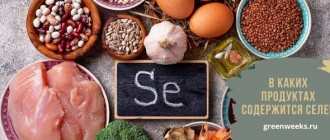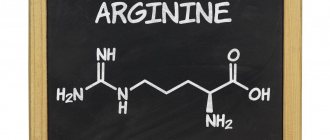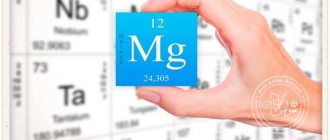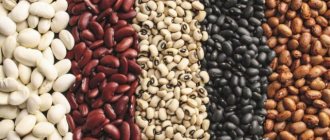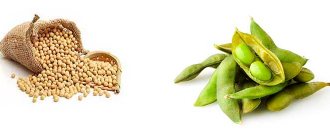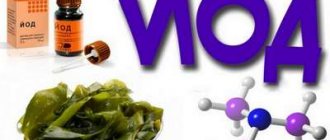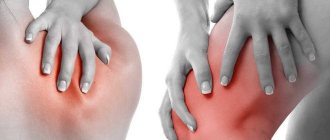The vitally important fat-soluble vitamin E, discovered in 1922 (by the way, this compound was discovered fifth among vitamins after a, b, c and d) was named tocopherol, which in Greek means the bringer of birth (“tokos” - birth, and “ ferro" – to carry).
Without the magic molecules of vitamin E on planet Earth, the reproductive function of all living organisms would simply fade away, since this compound is responsible for the health of the pelvic organs.
- Fat-soluble vitamin E is not synthesized in the human body; it can only be obtained from food, usually saturated with fat.
Having information about which foods contain the greatest amount of vitamin E, and how to competently create a daily menu, you can prevent the occurrence of a deficiency of this substance in the body and the associated failures in the smooth operation of all systems. Therefore, today we are publishing the most interesting and useful information about tocopherol.
The benefits of vitamin E for the body
Source of beauty and health!
The main functions of vitamin E in the human body:
- Tissue regeneration;
- Takes part in protein metabolism;
- Maintaining the functions of the thymus gland, which produces immune cells;
- Harmonization of the work of the sex glands, maintaining the reproductive function of the male and female body;
- Proper development and growth of the fetus during pregnancy;
- Protection of the body from radiological and electromagnetic radiation;
- Liver cell renewal;
- Neutralization of free radicals due to the penetration of vitamin E molecules into cell membranes;
- Blood circulation in large and small vessels, activation of access of oxygen molecules to all organs and tissues;
- Ensuring normal blood clotting;
- Nutrition of the organs of vision;
- Normalization of blood pressure;
- Nutrition and maintenance of elasticity of the skin (tocopherol is present in elastic and collagen fibers, which are the framework of our skin);
- Strengthening vascular walls, increasing their elasticity;
- Improving the processes of hematopoiesis, protection of red blood cells and iron absorption;
- Nutrition of the brain and maintenance of its normal cognitive functions.
Increased doses of tocopherol are required for fibrotic pathologies of the mammary glands, premenstrual syndrome, the threat of developing cataracts and the formation of blood clots, Alzheimer's disease, diabetes mellitus, injuries to bones and skin, the formation of scar tissue during the healing of wound surfaces, senile pigmentation, hypertension, cramps of the calf muscles.
Nutritionists recommend regularly consuming foods rich in vitamin E to protect the body from oxidative stress caused by the destructive effects of free radicals on cells (tocopherol is a universal protector of cell membranes from oxidative effects); accordingly, the substance is indispensable for prolonging youth and active longevity.
Many cosmetologists and dermatologists call tocopherol the vitamin of youth and beauty. This is true, since a sufficient intake of this compound from food ensures nutrition of the skin and appendages from the inside, preventing the premature appearance of large folds and fine wrinkles.
Mushrooms
Mushrooms are a unique creation of nature, a source of plant proteins. It contains many vitamins and microelements that are beneficial to humans. They have anti-cancer activity and support immunity. Disadvantage: they are difficult to digest; during heat treatment for food purposes, they lose some of the beneficial substances. Mushrooms are included in the list of foods that contain small amounts of vitamin E.
| Name | Vitamin E 100 g |
| Champignon | 0.2 mg |
| Porcini | 0.1 mg |
| Honey mushrooms | 0.1 mg |
It is difficult to find mushrooms suitable for food purposes with large amounts of vitamin E. Some sources indicate that there are species that can be up to 0.9 mg, but without specifying. If anyone is knowledgeable about mushrooms, please share the information.
Daily value of vitamin E for humans

How much vitamin E does a person need?
The amount of tocopherol in food is determined in international units (IU) or milligrams (mg). Moreover, for vitamin E, 1 IU is equal to approximately 0.7 mg.
- The daily dosage ranges from 3 to 28 IU, depending on the age, gender, characteristics and health status of the person.
So, for newborns 3-4 IU/day is enough (supply is provided by breast milk), for children (3-10 years old) - from 6 to 8 IU, for adolescents (10-16 years old) - from 8 to 18 IU, for women – 22 IU, for men – 24 IU, for women carrying a child – 24 IU, for women during lactation – from 24 to 28 IU. That is, the maximum daily dosage for an adult is about 20 mg of tocopherol.
Eggs and their derivatives
Eggs are not a food that contains high amounts of tocopherol. It is impossible to reach the daily dose when eating only eggs, because eating more than two eggs per day is not recommended. In addition to nutrients, protein, and minerals, the yolk contains a lot of cholesterol. The E content in eggs and derivative products is presented in the following table.
| Name | Vitamin E 100 g |
| Dry egg yolk powder | 2.1 mg |
| Chicken egg yolk | 2.0 mg |
| Quail egg | 0.9 mg |
| Chicken egg | 0.6 mg |
What foods contain vitamin E (table)?
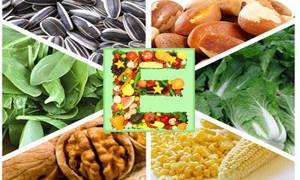
Where to look for the required element?
It is well known that the most vitamin E in foods is found in unrefined vegetable oils obtained by cold pressing and squeezing from seeds and nuts. Other sources of tocopherol include unroasted nuts, seeds and whole grains. A visual representation of vitamin E (which foods contain the most) is given by the following tables.
| Vegetable oils containing tocopherol | Amount of mg per 100 g of product |
| Wheat germ oil | 149,5 |
| Sunflower oil | 44 |
| Almond oil | 39,2 |
| Safflower oil | 34,1 |
| Palm oil | 33,1 |
| Corn oil | 18,6 |
| Soybean oil | 17,1 |
| Peanut butter | 16,7 |
| Olive oil | 12,1 |
| Poppy oil | 11,4 |
| Sesame oil | 8,1 |
| Cottonseed oil | 8,1 |
| Apricot kernel oil | 4 |
| Linseed oil | 2,1 |
| Peanut butter | 0,4 |
It should be noted that tocopherols are destroyed when heated, so it is advisable to use cold-pressed, unrefined vegetable oils as a salad dressing for fresh and boiled fruits, as well as as a gravy for slightly chilled cereal dishes.
| Products containing vitamin E | Tocopherol content per 100 g |
| Sunflower seeds | 31,2 |
| Almond | 26,22 |
| Hazelnut | 20,4 |
| Wheat germ breakfast cereal | 15,99 |
| Cedar | 11,3 |
| Wheat bran | 10,4 |
| Peanut | 9 |
| Cod liver, fish, canned food | 8,8 |
| Brazilian nut | 5,69 |
| Cashew | 5,7 |
| Olive pulp | 5 |
| Beluga game | 4 |
| Dried rose hips | 3,8 |
| Wheat, grain, durum varieties | 3,4 |
| Chum salmon caviar | 3 |
| Spinach | 2,5 |
| Dried pumpkin seeds | 2,18 |
| Avocado | 2,07 |
| Chicken egg | 2 |
| Salmon/salmon | 1,8 |
| Boiled oysters | 1,7 |
| Oats, grain, food | 1,4 |
| Atlantic fatty herring | 1,2 |
| Broccoli | 0,78 |
| Beef liver stew | 0,51 |
| Corn | 0,49 |
| Legumes | 0,21 |
As can be seen from the tables above, the main suppliers of tocopherols are products of plant origin, primarily seeds, nuts and cereals. Therefore, it is worth enriching your daily diet with just such food, and in small quantities. It is enough to eat a handful of peeled dried sunflower or almond seeds per day to provide the body with complete fat-soluble vitamins.
conclusions
Based on the data provided, let's make a list of the most vitamin-rich foods. It is convenient to refer to it when creating a menu for the week. Best available sources in descending order (taking into account different product groups):
- milk thistle oil,
- sunflower seeds,
- almond,
- Cod liver,
- sea buckthorn.
The main “supplier” is vegetable fats. I wouldn't bet on vegetables and fruits. They contain little vitamin, and they will not cover the daily requirement.
Sunflower plays an important role in replenishing the balance. It’s not for nothing that the useful habit of “husking seeds” has taken root in our country. The grains also contain a lot of selenium, an essential trace element for the proper functioning of the thyroid gland.
With this I say goodbye. I talked about vitamin E - where it is found, how to compensate for the deficiency, what food will help do this. Remember: the menu should be varied and must include vegetable fats, nuts, and various seeds.
Vitamin E is harmful in excess!
Excessive concentration of tocopherol in the body prevents the full absorption of other vitamin-like compounds. An overdose of vitamin E provokes malfunctions of organs and systems and can cause apathy, depression, allergic reactions, visual impairment, increased fatigue, loss of performance, weakness, drowsiness, and digestive problems.
Experienced cardiologists and neurologists argue that an overdose of tocopherol in smokers (a combination of vitamin and nicotine) can lead to a stroke.
Dairy and its derivatives
Milk is a source of calcium, phosphorus, and protein. Allowed for use from an early age. Dairy derivatives do not have a high concentration of E. The table shows how much vitamin E is in dairy products.
| Name | Vitamin E 100 g (mg) |
| Butter | 2,2 |
| Cream 30% | 0,55 |
| Soft cheese | 0,45 |
| Sour cream 20% | 0,4 |
| Cottage cheese | 0,38 |
| Hard cheese | 0,31 |
| Milk | 0,1 |
Lack of vitamin E – symptoms of deficiency
Systematic lack of vitamin E can lead to the development of the following pathological conditions:
- Cerebellar atoxia;
- Decreased immunity;
- Anemia caused by the destruction of red blood cells;
- Peripheral neuropathy;
- Diseases of internal organs (liver, pancreas);
- Muscular dystrophy;
- Migraine;
- Activation of aging processes;
- Deterioration in the absorption of nutrients in the intestines;
- Drying of the skin, peeling, appearance of premature wrinkles;
- Slowdown of metabolic processes and all the ensuing consequences (obesity, failure of the endocrine and reproductive systems, etc.).
9 signs of vitamin E deficiency:
- Fragility of nail plates;
- Dry skin;
- Muscle weakness;
- Hair splitting and dryness;
- Impaired movement coordination;
- Decreased sexual desire;
- Low hemoglobin levels in the blood;
- Failures in myocardial function;
- Cellulite, increase in the volume of subcutaneous fat.
Vegetables fruits
According to the advice of nutritionists, vegetables should be included in the basic human diet. This is the edible part, fruit or tuber, of plants. Refers to foods that are rich in vitamin E. In the Russian language, the word “fruit” did not exist until the time of Peter the Great. These are the fruits of trees and shrubs. In Rus' they referred to vegetables. Gifts of nature, rich in fiber, vitamins, microelements. The disadvantage of fruit is its high sugar content, so during diets it is recommended to eat it as a second breakfast. They belong to products with a high percentage of vitamin E.
| Name | Vitamin E 100 g (mg) |
| Sea buckthorn | 10,3 |
| Carrot | 5,0 |
| Green peas | 2,6 |
| Spinach | 2,5 |
| Broccoli | 2,43 |
| Dog-rose fruit | 1,71 |
| Peach | 1,5 |
| Rowan | 1,5 |
| Leek | 1,5 |
| Feather Bow | 1,0 |
| Brussels sprouts | 1,0 |
When preserved, they lose some of their beneficial properties. Summer has more fresh food, the best time to replenish nutrients.
Manifestations of overdose
REFERENCE. If you increase your intake of tocopherol 100 times, it ceases to be a vitamin. Becomes a medicine to reduce the risk of heart attacks and strokes. Prevents blood clotting.
A megadose of tocopherol (more than 1 g per day) can cause hypertriglyceridemia and increased blood pressure.
Manifestations of hypervitaminosis:
- thrombocytopenia, poor blood clotting;
- weakening of twilight vision;
- dyspeptic symptoms;
- headache, muscle cramps, weakness;
- decreased potency.
Vegetable oils
When asked what other foods contain vitamin E, the answer is vegetable oils. Produced by pressing and extraction from raw materials:
- oilseed;
- oilseeds;
- oily plant waste;
- nuts.
After extraction, they undergo purification - refining. There are solid and liquid consistency. The table shows which oil products contain the most vitamin E.
| Name | Vitamin E 100 g (mg) |
| Wheat germ | 215,4 |
| Soybeans | 114 |
| Cotton | 99 |
| Corn | 93 |
| Linen | 57 |
| Sunflower | 56 |
| Olive | 13 |
It is noticeable which oil has the highest concentration of vitamin E – wheat germ. One gram is enough to get the daily dose. Simply add to salad as a dressing.
Possible harm and side effects from taking vitamin E
It is almost impossible to harm yourself by consuming natural plant sources of vitamin E. You can only talk about side effects when taking pharmaceutical drugs and nutritional supplements. What are these side effects?
- Skin irritations;
- Nausea and headache;
- Bleeding;
- Fatigue and other symptoms.
It is noted that people taking blood thinners or other medications should never take vitamin E supplements without the approval of their healthcare provider. Researchers also discovered the following consequences of overdose and contraindications to taking vitamin E:
- Long-term use of vitamin E (more than 10 years) increases the risk of stroke.
- Daily doses of more than 400 IU of vitamin E increase the risk of death from all causes (possibly because it begins to act as a pro-oxidant).
- In patients with diabetes or cardiovascular disease, doses of 400 IU or more per day increase the risk of heart failure. Also, these doses should be avoided by people with high blood pressure.
- Vitamin E supplements may be harmful if taken early in pregnancy. One study found a link between pregnant women taking these supplements and congenital heart disease.
- Large doses of vitamin E are also dangerous for men because they increase the risk of developing prostate cancer.
It is always better to consume vitamins from food than from pharmaceutical preparations!
How to Get Vitamin E for Vegetarians
Vegetarianism is a lifestyle in which people refuse to eat food of animal origin. This happens for religious, ethical, and medical reasons. There are several types:
- pescetarianism - refusal of warm-blooded meat, it is allowed to eat fish, seafood, milk, eggs;
- ovolacto-vegetarianism - refusal of all types of slaughtered meat, milk and eggs are allowed;
- ovo-vegetarianism - eating only eggs from the animal world;
- lacto-vegetarianism - only milk;
- Veganism is a strict trend; only plants are allowed.
The views of such people are respectful, but many suffer from a lack of nutrients and essential amino acids. Those who have embarked on the path of restrictions need to know which foods are allowed to contain vitamin E, so as not to experience a deficiency. It is recommended to include in the diet:
- cereals, whole grain bread;
- oilseeds – wheat germ, soybean;
- nuts – walnuts, peanuts, seeds;
- vegetables - cabbage, carrots, fresh herbs;
- fruits – sea buckthorn, rose hips, peaches;
- mushrooms are a plant source of protein and amino acids.
Now Foods, Vegetarian Dry E-400, 268 mg (400 IU), 100 Veggie Caps
★★★★★
1 034 ₽
Buy at a discount
Garden of Life, Vitamin Code®, Raw Vitamin E, 60 Vegetarian Capsules
★★★★★
1 589 ₽
Buy at a discount
Bluebonnet Nutrition, Vitamin E Complex, 60 Liquid Capsules
★★★★☆
2 741 ₽
Buy at a discount
Varicose veins and vitamin E. Antioxidant properties in the fight against disease
When your legs hurt and cramp, what vitamins should you take? What vitamin strengthens the walls of blood vessels and will be beneficial for them? Of course, vitamin E. Its use has a powerful effect on the veins and blood vessels, it is effective in treating leg cramps. Its properties are used for the prevention and treatment of the first signs of varicose veins, as it:
- improves capillary permeability;
- ensures normal blood clotting, preventing thrombus formation;
- helps cleanse the walls of blood vessels, improving blood circulation along the vein;
- increases the elasticity of the venous walls, which prevents them from deforming.

There are various forms of release. It all depends on what these or those drugs will be used for. For example, vitamin E is included in remedies for varicose veins for external use. Venotonic "NORMAVEN®" foot cream includes 12 active natural ingredients. These include: panthenol, vitamins for strengthening veins and blood vessels (A, C and E), extracts of arnica, lingonberry, horse chestnut, ginkgo biloba and other carefully selected ingredients. This vitamin E cream is ideal for foot massage and skin care at home. The product must be distributed over the entire surface of the limbs and rubbed into the skin with light movements until completely absorbed.
Expert opinion
For weak blood vessels, to achieve the maximum therapeutic effect, the use of a cream based on vitamin E should be combined with the use of NORMAVEN®, a complex of venotonic vitamins and plant extracts. It will serve as an additional source of minerals, acids and other useful substances necessary in the fight against such an insidious disease as varicose veins.
Vascular surgeon, phlebologist
Osipova Ekaterina Yakovlevna
Foods containing vitamin E
Natural tocopherol is synthesized exclusively by plants, and therefore plant foods are considered its main source. The highest indicator is typical for unrefined vegetable oils obtained by cold pressing, since low temperatures during the processing of seeds and nuts make it possible to preserve the most valuable composition of plants. The leading position is occupied by wheat germ oil - just 1 tablespoon can compensate for the daily requirement of an adult for vitamin E.
Other vegetable oils are also rich in tocopherol: sunflower, rapeseed, olive, soybean, almond, etc. However, this useful substance can be obtained not only from oils - natural vitamin E is contained in the products from which these oils are extracted, and therefore can be consumed them in their original form.
Create a diet rich in vitamin E
A summary table will help you navigate among numerous sources and correctly create a fortified menu (the norms as a percentage of the daily requirement are indicated for an adult and are optimized taking into account variability).

| rice. | Product | A portion | Amount of vitamin E in mg | % of daily value |
| 1 | Almond | 60 g (1/4 cup) | 15,3 | 102 % |
| 2 | Wheat germ oil | 1 tbsp. l. (10 g) | 15 | 100 % |
| 3 | Hazelnut | 60 g (1/4 cup) | 9 | 60 % |
| 4 | Avocado, puree | 230 g (1 cup) | 6,12 | 41 % |
| 5 | Rice bran | 118 g (1 cup) | 5,81 | 39% |
| 6 | Sunflower oil | 1 tbsp. l. (13 g) | 5,75 | 38 % |
| 7 | Dried apricots | 130 (1 cup) | 5,63 | 38 % |
| 8 | Almond oil | 1 tbsp. l. (13 g) | 5,33 | 36 % |
| 9 | Wheat germ (sprouts) | 30 g (1/4 cup) | 5 | 33% |
| 10 | Safflower oil | 1 tbsp. l. (13 g) | 4,64 | 31 % |
| 11 | Spinach, puree | 156 g (1 cup) | 4,52 | 30 % |
| 12 | Rye flour | 128 g (1 cup) | Z.49 | 23% |
| 13 | Sweet potatoes, mashed | 328 g (1 cup) | Z.08 | 21 % |
| 14 | Cranberry juice | 253 g (1 cup) | Z.04 | 20 % |
| 15 | Orange juice | 240 g (1 cup) | Z.02 | 20 % |
| 16 | Peanut butter | 2 tbsp. l. (30 g) | 3 | 20 % |
| 17 | Pine nuts | 60 g (1/4 cup | 3 | 20 % |
| 18 | carrot juice | 236 g (1 cup) | 2,74 | 18 % |
| 19 | Broccoli, puree | 184 g (1 cup) | 2.4Z | 16 % |
Based on the table above, it is easy to create a complete menu for all family members and provide yourself and your loved ones with tasty and healthy fortified food, rich in vitamin E. This is the only way to maintain and increase your health and remain vigorous and cheerful for many years!


